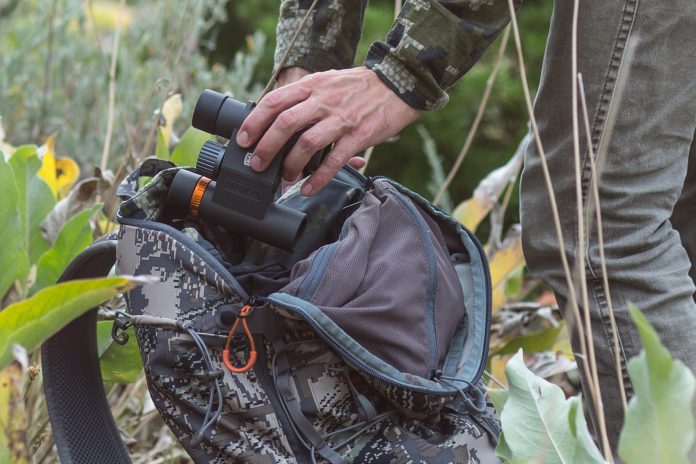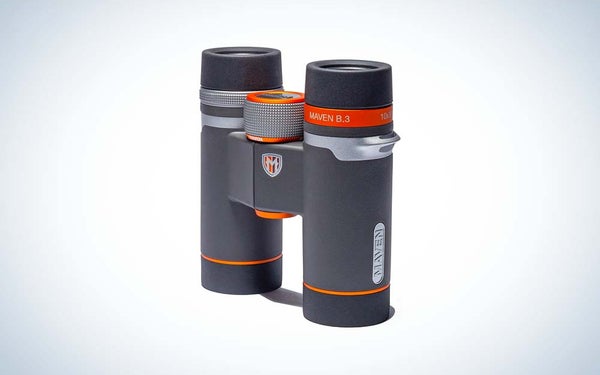We may earn revenue from the products available on this page and participate in affiliate programs. Learn more ›
Published Apr 18, 2023 5:02 PM
Some of the most frequently asked questions about birding surround optics, or more specifically, what type of binoculars to use for birding. The truth of the matter is there are dozens upon dozens of makes and models on the market. Some of these are elemental, while others pack features such as image stabilization, variable zoom, range-finding capabilities, and even night vision. We rounded up the best binoculars for birding and some tips to help you find the right model for you.
How We Made Our Picks
I’ve put various makes and models of binoculars through their paces over the years. I used them in every type of weather condition imaginable, whether hunting, birding, or watching wildlife. These experiences have helped me learn what features to look for in a good pair of binos. In this instance, I searched for a wide range of optics that run from entry-level and affordable to something more advanced and expensive. Here are some of the categories I focused on when determining the best binoculars for birding:
User-friendliness Rating
Some birders are capable of operating the latest/greatest and most sophisticated optics on the planet, but everyone isn’t that techno-savvy (myself included). So I looked for binos that are easy and comfortable to handle with good glass.
Field of View
Field of view is particularly important to birders who, more often than not, are trying to locate and focus on an object in motion, i.e. a flying bird. Therefore, a wide field of view—or a bigger viewing area side-to-side at a distance—is extremely helpful. Field of view is usually noted as a number in feet—what you can see—measured at 1,000 yards. Typical fields of view range from 300 to 450 feet.
Size and Weight
I looked for compact glass, as well as full-sized binoculars, for a couple of reasons. Compacts are nice if you’re hiking or carrying optics over a distance; however, because they’re light, stability (hand-shake) can be an issue. Full-size binoculars are bigger and heavier, and while less susceptible to shaking, they can prove cumbersome/awkward to pack any distance.
Durability
Chances are you’re not going to be crawling around in the brush with your new birding binoculars, but you might, as you try to get a good gander at that rufous-sided towhee. We also considered glass that offers some degree of protection, e.g. OEM armor covering.
Best Binoculars for Birding: Reviews & Recommendations
Best Overall: Maven B.3 Compact
Specs
- Frame: Polymer
- Weight: 16.6 ounces
- Objective Lens: 30mm
Pros
- Extra-low dispersion ED glass
- Fully-adjustable eyecups
- Waterproof/fog proof
- Fully multi-coated lenses
- Tripod adaptable
- Lifetime warranty
Cons
I’ve never been a compact binocular guy. My hands are big and I drink too much coffee to minimize the shake commonly associated with smaller/lighter glass. But the Maven B.3’s have changed the way I think about compact binoculars. Those who bird on their feet, i.e., hikers, will love the B.3’s pound-and-a-half weight. Hang them on a good bino harness, and you won’t know they’re there. The B.3 sports a 30mm objective lens and is available in 6X, 8X, or 10X, making them perfect for birders or hunters. They’re not bargain ($550), but they do come with an unconditional lifetime warranty, and that’s a big plus when it comes to outdoor gear.
Best Value: Steiner Predator Series
Specs
- Frame: Aluminum
- Weight: 26.3 ounces
- Objective Lens: 42mm
Pros
- Impressive clarity
- Variety of models within the Predator Series
- Waterproof
Cons
If you haven’t heard of Steiner and you spend time outdoors, my suggestion is to get out from under that rock. The German outfit is synonymous with quality optics and has been since its inception at the hands of Karl Steiner in 1947. What you’ll notice as soon as you put the Predator binos to your eyes is the world instantly becomes 10 times bigger, brighter, clearer, and closer. Yes, they’re that good. But quality isn’t inexpensive, and Steiner’s no exception; however, the Predator Series is a good mid-price option and includes a lengthy menu of magnifications, objective lenses, and focusing features.
Best Compact: Alpen Optics Wings 10×26 Compact
Specs
- Frame: Aluminum
- Weight: 20.8 ounces
- Objective Lens: 26mm
Pros
- Fully multi-coated
- Waterproof
- Affordable quality
- Lifetime warranty
- Durable
- Lightweight
Cons
I’ve owned and operated Alpen Optics for more than two decades now—compact binoculars, full-size binoculars, spotting scopes, riflescopes—and I really can’t think of anything negative to say about the glass or the company’s reputation. They make quality optics without the four-digit price tag. Birders will enjoy Alpen’s Wings Series of compact binos for several reasons. The glass is housed in a durable nicely-colored rough ‘n tumble body. Three compact models are available, including 8x26mm, 8x34mm, and for those who wish to view the world at 10x, a 10x26mm. They’re light, with the 8x26mm model tipping the scales at just a smidge over 20 ounces. Even better, they only cost $90.
Best Lightweight: Celestron Nature DX 8×42
Specs
- Frame: Poly
- Weight: 1.55 lbs
- Objective Lens: 42mm
Pros
- Eyeglass-friendly design/eyecups
- Tripod adaptable
- Accessory pack—everything the beginner needs
- Waterproof polycarbonate body
- Lifetime warranty
Cons
- Eyecups are a little flimsy
The Nature DX was the first Celestron model I ever tried, and I was very impressed. Now, experienced/hardcore birders may want something a little more in terms of visual quality, but for the novice or intermediate avian enthusiast, Celestron offers good glass at what I’d consider a very reasonable price ($150). The Nature DX has everything you’d want out of a bino—decent glass, multi-coated lenses, waterproof/fog proof construction, and a lifetime warranty. The armor coating improves durability, and the accessory pack includes additions like lens caps, an eyepiece rain-guard, a neck strap, a lens cleaning cloth, and a full instruction manual.
Best for Kids: Tasco Essentials Compact 8×21
Specs
- Frame: Blend
- Weight: 5.8 ounces
- Objective Lens: 21mm
Pros
- Affordable
- Durable
- User-friendly focusing wheel
- Great learning tool
Cons
These are kid’s binoculars meant for kids. Everything about them screams kid. From the choice of colors to the diminutive size and weight and the fact they have TASCO KIDS emblazoned on the top of the frame. But Tasco, a well-respected name in the optics arena, has smacked a home run with this one. Why? Well, they’re just cool on any number of levels. They’re eye-catching, work as intended, and are easy to operate, which means your little guy/gal isn’t going to get frustrated and throw them down. Even if they do, the armor is going to help. Plus, they’re on sale right now for $13.
What to Consider When Buying a Binocular
There are really only three things you need to consider when buying a binocular—price, magnification, and field of view. However, I tossed in a couple more variables that I look for, whether I’m buying the glass for birding, hunting, or toting in my fishing pack.
Price
If you can’t afford it, whatever “it” is, it does you no good. Binoculars will range from $150 to $1,000 or more. But you will find plenty of good options in the $200 to $400 category.
Magnification
It’s important to remember that the higher the magnification, the smaller/narrower the field of view, and the more likely you’re going to experience some degree of hand-shake. For birding, eight-power (8X) magnification is ideal; maybe 10 (10X), but nothing higher. Need more options? Six- and seven-power optics are also available and certainly worth putting on the list.
Field of View
As mentioned earlier, the field of view is significant to users, e.g. birders, who are trying to locate, focus on, and isolate a moving target. Three hundred to 450 feet at 1,000 yards is right there in the proverbial ballpark in terms of field of view, and, fortunately, most manufacturers of good optics will list a particular model’s field of view in the spec sheet.
Weight
The weight of your binos isn’t as big of a concern when you’re in a ground blind or car. But put them around your neck, and walk a couple of miles down a levee for a good glimpse at a courting pair of cinnamon teal, and you’ll want something lightweight. So, are you packing the glass around, or are you going to be sitting still?
FAQs
Q: What power binoculars do I need for birding?
Six-power (6X) to 10-power, or 10X, will serve any birder well. But remember, the higher the magnification, the narrower the field of view at 1,000 yards.
Q: Are compact binoculars better than full-size ones?
It depends on how you’re going to use them. Are you carrying them around your neck all day or packing them intermittently or not at all? Too, compacts, being smaller, are more prone to shake/vibration. Full-size optics are heavier, and that additional weight helps with steadiness.
Q: What’s the best binocular for kids?
For kids, you want something that meets these criteria: Simple focus adjustment, e.g. auto-focus or toggle focus; good durability; smaller frame, 6X to 8X magnification, with an objective lens of 30mm, and a strong neck strap.
Q: How much should a quality birding binocular cost?
The key word here is quality. The Internet is full of $9 binoculars, but that’s precisely what you’re getting—a $9 binocular. There are lots of options, but a good price range for quality glass is $150 to $400.
Q: Is “image stabilization” necessary when it comes to choosing a binocular?
Necessary, no, but it is a wonderful option, particularly for those of us who find ourselves overly caffeinated in the morning. The image stabilization (IS) feature does precisely as the name implies—it helps hold the image or view, not the optics themselves, steady, allowing a clearer or less shaky look at the world. Image stabilization comes at a price, with a low end of around $500 up to $10,000 for the top of the line.
Best Binoculars for Birding: Final Thoughts
Binoculars are like any other piece of outdoor gear you might purchase. Unless you want to repeat your transaction in the not-too-distant future, it’s advisable to buy the very best your pocketbook will allow. Look for a recognized and reputable manufacturer whose products you’ve done your homework. Decide, first, how you plan to spend your ‘birding time,’ i.e. hiking, driving, or sitting, as this will help determine the physical size/weight of the optics, and then pull the proverbial plug.
Why Trust Us
For more than 125 years, Field & Stream has been providing readers with honest and authentic coverage of outdoor gear. Our writers and editors eat, sleep, and breathe the outdoors, and that passion comes through in our product reviews. You can count on F&S to keep you up to date on the best new gear. And when we write about a product—whether it’s a bass lure or a backpack—we cover the good and the bad, so you know exactly what to expect before you decide to make a purchase.













